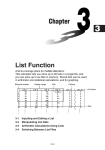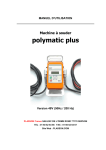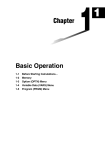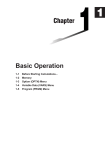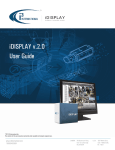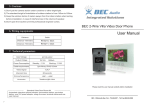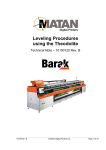Download Telemetering Service Manual
Transcript
TELEMETERING SERVICE MANUAL for NATIONAL FUEL GAS DISTRIBUTION CORPORATION National Fuel Gas Distribution Corporation Revised September 2014 Telemetering Service Manual Page 1 WHAT IS TELEMETERING ? Telemetering is add-on electronic equipment connected to gas meter(s) that collects and stores hourly readings from the meter(s) and then sends those hourly readings to a computer system in National Fuel Gas Distribution Corporation (“NFGDC”). The software determines hourly consumption and posts those readings and/or consumptions in a variety of formats. The resulting information is posted to the internet on the NFGDC Web Site for retrieval by customers or their authorized representatives. Generally, telemetering information is available each morning before Noon for the previous gas day (ending at 10:00 a.m. on the current day). Daily statements will be posted on the Transportation Scheduling System at approximately the same time for customers utilizing telemetering data for Daily Metered Transportation service. WHAT ARE THE BENEFITS OF TELEMETERING? Telemetering equipment can provide several advantages: Operation, maintenance, and accuracy of the telemetering components are all the responsibility of NFGDC. Once each day NFGDC posts a formatted report detailing gas consumption and meter readings for each day – which may be valuable information for production costing, scheduling, and budgeting. Gas Account Management is enhanced by ensuring that the delivery month, the usage month, and the billing month are identical time periods. WHAT DOES TELEMETERING COST? The typical cost for telemetering components can range from about $1,500 to about $4,000 for multiple meter sets, depending on the number of meters, the type of metering and the metering location(s) currently in place at a customer facility. This is a one-time, up-front charge, payable to NFGDC prior to installation. In addition, the customer must supply a dedicated analog phone line to each meter. The customer must have the components listed as "STANDARD REQUIREMENTS FOR TELEMETERING CAPABILITY," located within this document. National Fuel Gas Distribution Corporation Revised September 2014 Telemetering Service Manual Page 2 NATIONAL FUEL GAS DISTRIBUTION CORPORATION Instructions For Using Internet Web Site To Access Telemetering Data I. Requirements • • Access to Internet Access to generally available versions of Web Browser software, Microsoft Internet Explorer. II. Instructions 1. Access NFGDC’s Services for Marketers Web Site at http://www.natfuel.com/marketers/default.aspx 2. Click on Suppler/Customer File Download 3. Enter your User Name and Password. This will be supplied to customers and authorized representatives by NFGDC. 4. Scroll down to “Transportation Supplier/Customer Information”. Click on Mercury Device Daily Meter Read Report. 5. View Meter Reading/Consumption Reports on Screen Microsoft Explorer Instructions: • • • Left-Click on the link for the daily report to be viewed. The system will respond, “Do you want to open or save this file?” Select Open. 6. Download Reports to Your Computer Microsoft Explorer Instructions: • Left-Click on the link for the daily report to be viewed. • The system will respond, “Do you want to open or save this file?” • Select Save. National Fuel Gas Distribution Corporation Revised September 2014 Telemetering Service Manual Page 3 • Enter the Directory and File Name. • The reports will be saved as an ASCII Text File. • To view and/or print the file, retrieve it using word processing software such as Microsoft Word or a text editor such as Notepad. 7. View Meter Reading/Consumption Graphs on Screen • Left-Click on the link for the daily graph to be viewed - Graphs. 8. Download Meter Data to Your Computer • Right-Click on the link for the daily data download – Download File. • Select Save Target As… • Enter the Directory and File Name. • The reports will be saved as an ASCII Text File in .CSV format in the following layout: "RBA_NUM","RBA_NAME","SITE_ID","GAS_DAY","READ_TIME","READ","CORR_READ" "98765432","CUSTOMER NAME","009999999","20060601","11:00:00 ","24","87567" • To view and/or print the file, retrieve it using spreadsheet software such as Microsoft Excel or a text editor such as Notepad. 9. Exit out of Web Browser software when done viewing and/or downloading the reports. National Fuel Gas Distribution Corporation Revised September 2014 Telemetering Service Manual Page 4 THE COMPONENTS OF TELEMETERING Telemetering consists of the following components: MERCURY (ELECTRONIC) CORRECTOR This device accounts for temperature and pressure variations (such as delivering high-pressure gas) of the gas being delivered, that the metering cannot correct for itself. On a low-pressure delivery meter setting, a pulse accumulator is utilized to receive pulse outputs from the metering equipment. MODEM MOUNTING ASSEMBLY This includes the modem, as well as the necessary hardware required to support it. Typically the modem is either pipe mounted or wall mounted. If it is pipe mounted the installation utilizes a standard threaded pipe saddle along with a 2” x 18” pipe nipple. The modem case includes a pipe stand bracket and setscrews to attach to the pipe. If the modem is directly secured to the pipe, then the network interface is installed on the modem case. In certain instances the pipe stand bracket may be mounted to either a plywood board or metal plate. The modem and network interface are then affixed to the board or metal plate utilizing screws and bolts as required. If the modem is wall mounted, the installation is similar however the pipe saddle, and pipe stand bracket are not required. NETWORK INTERFACE BOX This is a small plastic box mounted on the Modem Mounting Assembly or Modem Case. Inside this box is where the telemetering equipment connects with the phone line used to “call in” meter readings each day. A typical complete Telemetering Equipment package is pictured on the next page. National Fuel Gas Distribution Corporation Revised September 2014 Telemetering Service Manual Page 5 National Fuel Gas Distribution Corporation Revised September 2014 Telemetering Service Manual Page 6 WHAT IS PULSE ACCESS? In addition to telemetering, another means to access consumption information is to take the pulse signal directly from the meter. This signal can then be used in conjunction with software to perform simple functions such as calculating basic consumption information or more complex functions such as integrating the real time measurement into an energy management system to monitor and control equipment or functions within a facility. WHAT ARE THE BENEFITS OF A PULSE ACCESS? PULSE ACCESS differs from telemetering because with direct access to the pulses, a customer can have continuous real-time data. In comparison, telemetering data is only available on a daily basis in hourly intervals. This real-time feature is often very attractive to customers with sophisticated energy management systems at their facilities. Real time pulse access can provide gas consumption during specific time frames on a specific process that may be used by energy managers to optimize the use of gas energy. The installation cost that NFGDC charges the customer for Pulse Access is generally less expensive than for telemetering. Pulse access has its limitations and drawbacks, though. When NFGDC provides a customer with access to the pulse data coming from the measurement equipment, NFGDC’s responsibility ends at the point where pulses are supplied. Not only must the customer provide the line from that interface point to the customer’s receiving computer(s), but also must provide all hardware and software to receive, interpret, and report. FEATURES OF TELEMETERING VERSUS PULSES ONLY Features of Telemetering 1. Gathering signals from the customer’s meters, interpreting those signals and processing the data is the sole responsibility of NFGDC. 2. Approximately at the same time every day, the customer receives a standard report that details gas consumption over the last 24 hours. 3. Installation of the telemetering equipment by NFGDC is generally more expensive than the installation of the equipment for pulses only. 4. The hardware a customer needs for telemetering is fairly basic. Most customers will already have the hardware needed for Internet access (see “Standard Requirements For Telemetering Capability”). 5. The customer is responsible for running telephone line(s) to the meter set and ensures the line(s) are operational. National Fuel Gas Distribution Corporation Revised September 2014 Telemetering Service Manual Page 7 Features of Pulses Only 1. NFGDC provides a pulse at the meter set. The customer is responsible for everything beyond that point including the line(s) from the meter set to the customer’s receiving equipment and all equipment (hardware and software) needed to receive and interpret the pulses provided by NFGDC. The interconnection of the line with the meter set shall be performed by NFGDC. The customer is not permitted to make any modifications to or perform any work on NFGDC facilities. 2. The customer has access to real-time gas consumption data. 3. Installation of the pulses-only equipment by NFGDC is generally less expensive than the installation of the equipment for telemetering. The customer pays NFGDC a one-time fee for installing the equipment that delivers the pulses. All maintenance fees will be internal to the customer. 4. Service calls by NFGDC personnel for pulsing equipment shall be scheduled as non-emergency work based on availability. 5. Customer shall be responsible for all costs associated with service calls by NFGDC at the request of the customer where NFGDC’s equipment is determined to be functioning properly. 6. Gas account billing is based on readings from NFGDC’s mechanical meters and not the pulsing equipment, which is installed solely for informational use by the customer. No adjustments to billing will result due to discrepancies between the two systems. PULSE INSTALLATION SPECIFICATIONS 1. NFGDC will install one standard two terminal network interface box per instrument, mounted on or near the back of the instrument. All customer access to pulses is provided through the interface box. 2. Outputs are Form-A, (2 wire) wetted open collector contacts. 3. Outputs are isolated from the ground and from each other. 4. Outputs are rated for DC only, from 3v to 30v. No power is provided. Observe polarity. 5. The pulse circuit will sink up to 5 milliamperes. 6. Output counts consist of contact closures held for 62.5 milliseconds. 7. Each contact closure represents 1000 standard cubic feet of gas (corrected volume) unless otherwise stated. National Fuel Gas Distribution Corporation Revised September 2014 Telemetering Service Manual Page 8 WHAT DATA DO I RECEIVE WITH ELECTRONIC TELEMETERING? NFGDC receives the reading and consumption data each day. This data is formatted and posted for retrieval by the customer or its authorized representative via the Internet. The following pages show examples of detail reports and graphs. National Fuel Gas Distribution Corporation Revised September 2014 Telemetering Service Manual Page 9 ESRN1120 PRODUCED FOR METER READING / CONSUMPTION REPORTING REPORTING PERIOD IS 08/01/yy TO 08/13/yy CONSUMPTION IS REPORTED IN MCF RUN DATE: 08/14/yy RUN TIME: 04:28 PM RECIPIENT ID: 00000 RBA NUM: 0000000 --------------------------------------------------------------------------------------------DISTRIBUTION COMPANY CUSTOMER MAIN ST RBA NUM: OOOOOOO MTR LOC NUM: 000000 MTR NUM: 000000 --------------------------------------------------------------------------------------------GAS CUMULATIVE DAY CONSUMPTION CONSUMPTION --------------------------------------------------------------------------------------------08/01/yy 0 0 08/02/yy 4 4 08/03/yy 9 13 08/04/yy 1 14 08/05/yy 0 14 08/06/yy 0 14 08/07/yy 0 14 08/08/yy 10 24 08/09/yy 6 30 08/10/yy 0 30 08/11/yy 0 30 08/12/yy 0 30 08/13/yy -----------------------------------------------------------------------------------TIME READINGS CONS CUML -------------------------------------------------------11:00 AM 857082 0 0 12:00 PM 857082 0 0 1:00 PM 857082 0 0 2:00 PM 857082 0 0 3:00 PM 857082 0 0 4:00 PM 857082 0 0 5:00 PM 857082 0 0 6:00 PM 857082 0 0 7:00 PM 857082 0 0 8:00 PM 857082 0 0 9:00 PM 857082 0 0 10:00 PM 857082 0 0 11:00 PM 857082 0 0 12:00 AM 857082 0 0 1:00 AM 857082 0 0 2:00 AM 857082 0 0 3:00 AM 857082 0 0 4:00 AM 857082 0 0 5:00 AM 857082 0 0 6:00 AM 857082 0 0 7:00 AM 857082 0 0 8:00 AM 857083 1 1 9:00 AM 857084 1 2 10:00 AM 857086 2 4 ------------------------------------------------------------------------------------ National Fuel Gas Distribution Corporation Revised September 2014 Telemetering Service Manual Page 10 National Fuel Gas Distribution Corporation Revised September 2014 Telemetering Service Manual Page 11 STANDARD REQUIREMENTS FOR TELEMETERING CAPABILITY Data Access Via The NFGDC Web Site 1. Hardware: Minimum CPU: Suggested CPU: Memory: Display Resolution: i3, 3.3GHz or equivalent Minimum to support selected Browser 2GB 800 x 600 2. Operating Systems: Any operating system that supports minimum Browser versions 3. Connection: Minimum: 1.5 - 3MB Suggested: ISDN, DSL/ADSL, Cable modem Also suggest multiple independent connections: e.g., Multiple dial-up ISP’s or Cable Modem and backup dial-up connection. 4. Browser Characteristics: Microsoft Internet Explorer v9 or higher 5. Example of a typical Client Setup: Hardware: CPU: 3.3 GHz processor Memory: 6 GB Physical Display Resolution: 800 x 600 Standard Pointing Device (mouse/trackball) Operating Systems: Windows 7 Connection: Cable Modem 56KB (V90) modem (as backup) Cell Phone dialup to backup land line Browser: Microsoft Internet Explorer v9 or higher National Fuel Gas Distribution Corporation Revised September 2014 Telemetering Service Manual Page 12 6. One dedicated, analog telephone line per modem. Shared telephone lines or extensions should not be utilized. The customer is responsible for arranging installation of this telephone line and ensuring it is operational before NFGDC installs any telemetering equipment. The telephone line will be connected by NFGDC to the network interface box at the meter setting. NFGDC personnel require 25 feet of extra telephone line on the meter setting to allow for connecting the line to the telemetering equipment. 7. The customer must inform NFGDC of any prefix that needs to be dialed to make an outgoing call on each telephone line and must also provide NFGDC with the telephone number of each line installed to allow for incoming diagnostic calls. Windows is a registered trademark of Microsoft Corporation Internet Explorer and Active X are registered trademarks of Microsoft Corporation. National Fuel Gas Distribution Corporation Revised September 2014 Telemetering Service Manual Page 13 NATIONAL FUEL GAS DISTRIBUTION CORPORATION 6363 MAIN STREET ENERGY SERVICES WILLIAMSVILLE, NY 14221 Date:______________________ REQUEST FOR QUOTATION - INSTALLATION OF TELEMETERING/PULSE EQUIPMENT Attn: Mike Bender x2588 Rob Albers x4394 Requested By: ES Sales Rep Phone Extension Customer Name (in C.I.S.) Service Address: ____________________ __________________________ Street ______________ City/Town Zip RBA# Customer Contact Person * _______________________ _________________ Name _________________ Title Phone # (* Must be familiar with actual meter location(s) on customer’s premises.) Email Address Request For: Pulse Output Telemetering For the Following Meter(s) No. Deadline, if any, for quotation to be made: Type Location / / Has a consultant been authorized by the customer to communicate with NFGDC regarding this request? If so, NAME FIRM PHONE EMAIL ADDRESS National Fuel Gas Distribution Corporation Revised September 2014 Telemetering Service Manual Page 14
















